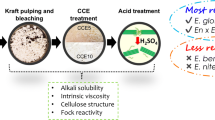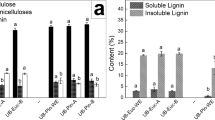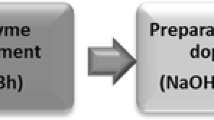Abstract
This study assesses the possibility of obtaining regenerated cellulose products (beads and films) from eucalyptus sawdust dissolving pulps produced by non-conventional processes, compared with a commercial dissolving pulp as a reference. Eucalyptus sawdust dissolving pulps were obtained by soda pul** followed by two TCF sequential bleaching processes OOpZ, and OOp, followed by a cold soda extraction. The characterization of dissolving pulps involved alpha-, beta- and gamma-cellulose content, alkali solubility with 10 wt% (S10), and 18 wt% NaOH (S18) aqueous solutions, and degree of polymerization. Fock´s method was used to measure cellulose reactivity and the alkali solubility in a 9 wt% NaOH aqueous solution at − 5 °C to evaluate the pulps dissolving capacity. Dissolving pulps presented high cellulose content (> 93%, expressed as α-cellulose) and good reactivity (almost 8%). The dissolving pulps were adequate raw materials for regenerated cellulose products (beads and films) from two cellulose dissolution methods: direct dissolution in NaOH/urea and cellulose carbamate solution. The sequence OOpE (where E is an alkaline extraction) was more economically feasible and straightforward to produce dissolving pulp than OOpZE. The experimental pulps showed the expected characteristics of the dissolving pulp to obtain regenerated cellulose products. However, it is necessary to deepen the study of producing regenerated cellulose films with enhanced mechanical properties from experimental dissolving pulps, solvents, coagulation, and regeneration conditions.






Similar content being viewed by others
References
Abdou Alio M, Marcati A, Pons A, Vial C (2021) Modeling and simulation of a sawdust mixture-based integrated biorefinery plant producing bioethanol. Bioresour Technol 325:124650. https://doi.org/10.1016/j.biortech.2020.124650
Arce C, Llano T, García P, Coz A (2020) Technical and environmental improvement of the bleaching sequence of dissolving pulp for fibre production. Cellulose 27:4079–4090. https://doi.org/10.1007/s10570-020-03065-1
Budtova T, Navard P (2016) Cellulose in NaOH–water based solvents: a review. Cellulose 23:5–55. https://doi.org/10.1007/s10570-015-0779-8
Carrillo-Varela I, Retamal R, Pereira M, Mendonça RT (2019) Structure and reactivity of cellulose from bleached kraft pulps of different Eucalyptus species upgraded to dissolving pulp. Cellulose 26:5731–5744. https://doi.org/10.1007/s10570-019-02491-0
Chen C, Duan C, Li J et al (2016) Cellulose (Dissolving Pulp) manufacturing processes and properties: a mini-review. BioResources 11:5553–5564
Chen Z, Zhang H, He Z, Zhang L (2019) Current and future markets of dissolving pulp in China and other countries. BioResources 14:7627–7629
Clauser NM, Gutiérrez S, Area MC et al (2018) Alternatives of small-scale biorefineries for the integrated production of xylitol from sugarcane bagasse. J Renew Mater. https://doi.org/10.7569/JRM.2017.634145
Ettenauer M, Loth F, Thümmler K et al (2011) Characterization and functionalization of cellulose microbeads for extracorporeal blood purification. Cellulose 18:1257–1263. https://doi.org/10.1007/s10570-011-9567-2
Fink H-P, Ganster J, Lehmann A (2014) Progress in cellulose sha**: 20 years industrial case studies at Fraunhofer IAP. Cellulose 21:31–51. https://doi.org/10.1007/s10570-013-0137-7
Fock W (1959) Eine modifizierte method zur bestimmung der reaktivitat von zellstoffen fur viskosherstellung. Das Pap 13:92–95
Fu F, Guo Y, Wang Y et al (2014a) Structure and properties of the regenerated cellulose membranes prepared from cellulose carbamate in NaOH/ZnO aqueous solution. Cellulose 21:2819–2830. https://doi.org/10.1007/s10570-014-0297-0
Fu F, Yang Q, Zhou J et al (2014) Structure and properties of regenerated cellulose filaments prepared from cellulose carbamate–NaOH/ZnO aqueous solution. ACS Sustain Chem Eng 2:2604–2612. https://doi.org/10.1021/sc500559g
Fu F, Zhou J, Zhou X et al (2014) Green method for production of cellulose multifilament from cellulose carbamate on a pilot scale. ACS Sustain Chem Eng 2:2363–2370. https://doi.org/10.1021/sc5003787
Fu F, Xu M, Wang H et al (2015) Improved synthesis of cellulose carbamates with minimum urea based on an easy scale-up method. ACS Sustain Chem Eng 3:1510–1517. https://doi.org/10.1021/acssuschemeng.5b00219
Gavrilescu D (2013) Pul** fundamentals and processing. In: Popa VI (ed) Pulp production and processing: from papermaking to high-tech products. Smithers Rapra Technology Ltd, pp 35–69
Gehmayr V, Sixta H (2012) Pulp properties and their influence on enzymatic degradability. Biomacromolecules 13:645–651. https://doi.org/10.1021/bm201784u
Gemeiner P, Beneš MJ, Štamberg J (1989) Bead cellulose and its use in biochemistry and biotechnology. Chem Pap 46:805–848
Gericke M, Trygg J, Fardim P (2013) Functional cellulose beads: preparation, characterization, and applications. Chem Rev 113:4812–4836. https://doi.org/10.1021/cr300242j
Ghaderi M, Mousavi M, Yousefi H, Labbafi M (2014) All-cellulose nanocomposite film made from bagasse cellulose nanofibers for food packaging application. Carbohydr Polym 104:59–65. https://doi.org/10.1016/j.carbpol.2014.01.013
Gindl W, Keckes J (2005) All-cellulose nanocomposite. Polym (Guildf) 46:10221–10225. https://doi.org/10.1016/j.polymer.2005.08.040
Guigou M, Cabrera MN, Vique M et al (2019) Combined pretreatments of eucalyptus sawdust for ethanol production within a biorefinery approach. Biomass Convers Biorefinery 9:293–304. https://doi.org/10.1007/s13399-018-0353-3
Hagman J, Gentile L, Jessen CM et al (2017) On the dissolution state of cellulose in cold alkali solutions. Cellulose 24:2003–2015. https://doi.org/10.1007/s10570-017-1272-3
Huang K, Wang Y (2022) Recent applications of regenerated cellulose films and hydrogels in food packaging. Curr Opin Food Sci 43:7–17. https://doi.org/10.1016/j.cofs.2021.09.003
Isogai A, Atalla RH (1998) Dissolution of cellulose in aqueous NaOH solutions. Cellulose 5:309–319. https://doi.org/10.1023/A:1009272632367
Kamusoko R, **gura RM, Parawira W, Chikwambi Z (2021) Strategies for valorization of crop residues into biofuels and other value-added products. Biofuels Bioprod Biorefining. https://doi.org/10.1002/bbb.2282
Kang Y, Wang F, Zhang Z, Zhou J (2021) Dissolution and interaction of cellulose carbamate in NaOH/ZnO aqueous solutions. Polym (Basel) 13:1092. https://doi.org/10.3390/polym13071092
Köpcke V, Ibarra D, Larsson PT, Ek M (2010) Optimization of treatments for the conversion of eucalyptus kraft pulp to dissolving pulp. Polym from Renew Resour 1:17–34. https://doi.org/10.1177/204124791000100102
Kosan B, Römhild K, Meister F et al (2020) Enzymatic pulp modification: an excellent way to expand the raw material base for. Lyocell applications? Cellulose 27:6577–6590. https://doi.org/10.1007/s10570-020-03243-1
Kumar H, Christopher LP (2017) Recent trends and developments in dissolving pulp production and application. Cellulose 24:2347–2365. https://doi.org/10.1007/s10570-017-1285-y
Liu Y, Shi L, Cheng D, He Z (2016) Dissolving pulp market and technologies: Chinese prospective - a mini-review. BioResources 11:2016
Marx-Figini M (1987) The acid-catalized degradation of cellulose linters in distinct ranges of degree of polymerization. J Appl Polym Sci 33:2097–2105
Mendes ISF, Prates A, Evtuguin DV (2021) Production of rayon fibres from cellulosic pulps: State of the art and current developments. Carbohydr Polym 273:118466. https://doi.org/10.1016/j.carbpol.2021.118466
Peška J, Štamberg J, Hradil J, Ilavský M (1976) Cellulose in bead form. J Chromatogr A 125:455–469. https://doi.org/10.1016/S0021-9673(00)85709-X
Pinnow M, Fink H-P, Fanter C, Kunze J (2008) Characterization of highly porous materials from cellulose carbamate. Macromol Symp 262:129–139. https://doi.org/10.1002/masy.200850213
Rahkamo L, Siika-aho M, Viikari L et al (1998) Effects of cellulases and hemicellulase on the alkaline solubility of dissolving pulps. Holzforschung 52:630–634
Rangel J, Hornus M, Felissia FE, Area MC (2016) Hydrothermal treatment of eucalyptus sawdust for a forest biorefinery. Cellul Chem Technol 50(5–6):521–528
Sayyed AJ, Deshmukh NA, Pinjari DV (2019) A critical review of manufacturing processes used in regenerated cellulosic fibres: viscose, cellulose acetate, cuprammonium, LiCl/DMAc, ionic liquids, and NMMO based lyocell. Cellulose 26:2913–2940. https://doi.org/10.1007/s10570-019-02318-y
Schild G, Sixta H (2011) Sulfur-free dissolving pulps and their application for viscose and lyocell. Cellulose 18:1113–1128. https://doi.org/10.1007/s10570-011-9532-0
Shibata M, Teramoto N, Nakamura T, Saitoh Y (2013) All-cellulose and all-wood composites by partial dissolution of cotton fabric and wood in ionic liquid. Carbohydr Polym 98:1532–1539. https://doi.org/10.1016/j.carbpol.2013.07.062
Singh P, Duarte H, Alves L et al (2015) From cellulose dissolution and regeneration to added value applications—synergism between molecular understanding and material development. In: Poletto M, Ornaghi H Jr et al (eds) Cellulose-fundamental aspects and current trends. InTech, Rijeka, pp 1–44
Sixta H, Iakovlev M, Testova L et al (2013) Novel concepts of dissolving pulp production. Cellulose 20:1547–1561. https://doi.org/10.1007/s10570-013-9943-1
Stafford W, De Lange W, Nahman A et al (2020) Forestry biorefineries. Renew Energy 154:461–475. https://doi.org/10.1016/j.renene.2020.02.002
Vo LTT, Široká B, Manian AP, Bechtold T (2010) Functionalisation of cellulosic substrates by a facile solventless method of introducing carbamate groups. Carbohydr Polym 82:1191–1197. https://doi.org/10.1016/j.carbpol.2010.06.052
Wang L, Zhang Y, Gao P et al (2006) Changes in the structural properties and rate of hydrolysis of cotton fibers during extended enzymatic hydrolysis. Biotechnol Bioeng 93:443–456. https://doi.org/10.1002/bit.20730
Wang Y, Zhao Y, Deng Y (2008) Effect of enzymatic treatment on cotton fiber dissolution in NaOH/urea solution at cold temperature. Carbohydr Polym 72:178–184. https://doi.org/10.1016/j.carbpol.2007.08.003
Xu M, Li T, Zhang S et al (2021) Preparation and characterization of cellulose carbamate membrane with high strength and transparency. J Appl Polym Sci 138:50068. https://doi.org/10.1002/app.50068
Yang Y, Zhang Y, Dawelbeit A et al (2017) Structure and properties of regenerated cellulose fibers from aqueous NaOH/thiourea/urea solution. Cellulose 24:4123–4137. https://doi.org/10.1007/s10570-017-1418-3
Yousefi H, Nishino T, Faezipour M et al (2011) Direct fabrication of all-cellulose nanocomposite from cellulose microfibers using ionic liquid-based nanowelding. Biomacromolecules 12:4080–4085. https://doi.org/10.1021/bm201147a
Zhang S, Yu C, Liu N et al (2019) Preparation of transparent anti-pollution cellulose carbamate regenerated cellulose membrane with high separation ability. Int J Biol Macromol 139:332–341. https://doi.org/10.1016/j.ijbiomac.2019.07.146
Zhou J, Zhang L, Shu H, Chen F (2002) Regenerated cellulose films from NaOH/urea aqueous solution by coagulating with sulfuric acid. J Macromol Sci Part B 41:1–15. https://doi.org/10.1081/MB-120002342
ANDRITZ (2021) Development deal for commercializing textile fiber regeneration technology. In: https://www.andritz.com/spectrum-en/development-deal-for-commercializing-textile-fiber-regeneration-technology
Klemm D, Philipp B, Heinze T et al (1998) Appendix to volume 2: experimental procedures for the functionalization of cellulose. In: Klemm D, Philipp B, Heinze T (eds) Comprehensive cellulose chemistry. Wiley-VCH Verlag GmbH, pp 327–375
Lanieri DB (2017) Doctoral thesis dissertation: Obtención y caracterización de carbamato de celulosa como alternativa de disolución al proceso de viscosa. Facultad de Ingeniería Química, Universidad Nacional del Litoral, http://hdl.handle.net/11185/943
Lue A, Zhang L (2010) Advances in aqueous cellulose solvents. pp 67–89
Manhaes GF, Ferreira Lima A (2001) Solucell: a special dissolving pulp from eucalyptus. In: 7th Brazilian Symposium on the Chemistry of lignins and other wood components
Olmos GV (2016) Doctoral Thesis Dissertation: Alternativas de disolución de celulosa para la obtención de productos regenerados. Facultad de Ingeniería Química, Universidad Nacional del Litoral. http://hdl.handle.net/11185/945
Rana S, Pichandi S, Parveen S, Fangueiro R (2014) Regenerated cellulosic fibers and their implications on sustainability. pp 239–276
Simon M, Barrufaldi S, Clauser N et al (2017) Residuos de Industrialización Primaria de la Madera como materia prima para biorrefinerías. Estudio de localización en Misiones (Argentina). Rev. El Pap
Sixta H (2006) Handbook of Pulp Volumen I. Weinheim
Wang Y (2008) Cellulose fiber dissolution in sodium hydroxide solution at low temperature: dissolution kinetics and solubility improvement, PhD Thesis., Georgia Institute of Technology, Atlanta, US
Acknowledgments
The authors acknowledge financial support from Projects of Scientific and Technological Research (PICT-Raíces) of the AGENCIA-MINCYT. The USDA National Institute of Food and Agriculture, Hatch program (ALA013-17003) and McIntire-Stennis program (1022526) financial support to complete this work is much appreciated.
Funding
This work was supported by Projects of Scientific and Technological Research (PICT-Raíces, 2015-N° 2843) of the AGENCIA-MINCYT and the USDA National Institute of Food and Agriculture, Hatch program (ALA013-17003) and McIntire-Stennis program (1022526).
Author information
Authors and Affiliations
Corresponding author
Ethics declarations
Conflict of interest
The authors have no conflicts of interest to declare that are relevant to the content of this article.
Additional information
Publisher’s Note
Springer Nature remains neutral with regard to jurisdictional claims in published maps and institutional affiliations.
Rights and permissions
About this article
Cite this article
Vallejos, M.E., Olmos, G.V., Taleb, M.C. et al. Dissolving pulp from eucalyptus sawdust for regenerated cellulose products. Cellulose 29, 4645–4659 (2022). https://doi.org/10.1007/s10570-022-04581-y
Received:
Accepted:
Published:
Issue Date:
DOI: https://doi.org/10.1007/s10570-022-04581-y




